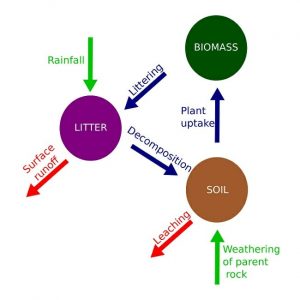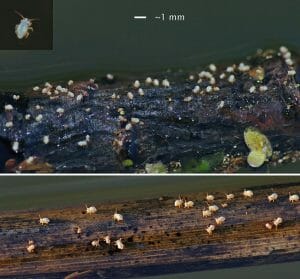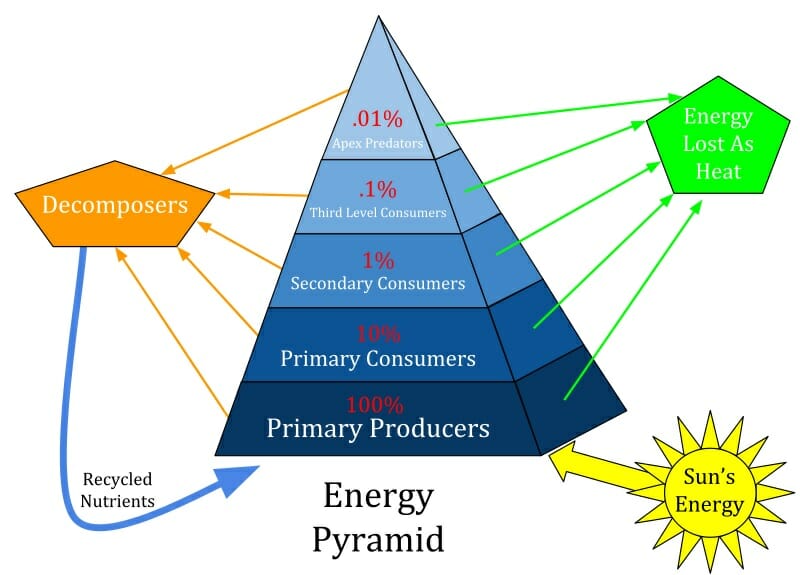Detritivore Definition
A detritivore is a heterotrophic organism, which obtains its nutrition by feeding on detritus. Detritus is the organic matter made up of dead plant and animal material. Detritivores may also obtain nutrition by coprophagy, which is a feeding strategy involving the consumption of feces.
Detritivores are often invertebrate insects such as mites, beetles, butterflies and flies; mollusks such as slugs and snails; or soil-dwelling earthworms, millipedes and woodlice.
Examples of detritivores in marine environments are crustaceans such as crabs and lobsters, echinoderms such as sea stars or sea cucumbers. Many of these marine detritivores occupy a similar niche to terrestrial soil-dwellers, living on or within the seabed known as the benthos. These organisms are often called “bottom-feeders”. Alternatively in aquatic ecosystems, stationary polychaete worms, barnacles and some corals derive their energy through filter feeding on floating organic detritus called ”marine snow”.
The terms “detritivore” and “decomposer” are distinct in their meaning; although the words are often used interchangeably, detritivores are technically a branch of decomposers. It is useful to note that, unlike detritivores, true decomposers such as fungi, bacteria or protists, use saprotrophic feeding, in which they absorb nutrients through extracellular digestion, rather than by oral ingestion. Similarities can however be drawn between detritivores and scavengers. Yet while both of these feeding strategies involve the consumption of dead plant and animal matter, scavengers tend to feed on a larger scale than detritivores, specializing on carrion and feces.
Function of Detritivores
Detritivores and decomposers contribute to the breakdown of all of the dead and decaying material in any ecosystem. In this way they play an important role in the cycling of nutrients and are an essential part of most biogeochemical cycles, such as the carbon cycle, nitrogen cycle and the phosphorus cycle.
Detritivores feed on material from primary producers as well as herbivores and carnivores, and thus are present throughout all trophic levels in an ecosystem. As well as consuming energy from other organisms, detritivores are commonly eaten by secondary consumers, and so they are an integral component of the ecosystem energy cycle.
Not only is the recycling process an important part of decomposition, the removal of dead material is important to stop the spread of disease. Additionally, detritivores that live within the soil, e.g. earthworms, aerate and mix up the soil with their movement, which is important for the growth of plants.
The Decomposition Cycle
Detritus is made up of Particulate Organic Material (POM) that is formed from tissues deposited when plants and animals die or when they shed skin or antlers through molting, as well as fecal matter and microorganisms. The colonies of microorganisms within the detritus add to its nutritional value. In terrestrial environments, detritus may be present as humus (the dead materials mixed with soils), or as leaf litter. In aquatic environments, the detritus is suspended as “marine snow”, which eventually falls to the seabed.
All of this material contains energy, as well as the nutrients that were present in the waste material and the bodies of the deceased. These substances are valuable commodities in all energy and nutrient cycles, although the minerals and compounds must be made available by physical breakdown and biochemical transformation of the material through decomposition or remineralisation.
Detritivores feed on the larger particulate material in the early stages of decomposition, and in doing so, fragment the material in to smaller sized pieces. The fragmentation process increases the surface area available, for attack by bacteria and other microorganisms, and thus assists and speeds up the decomposition process.
Digestion by the detritivores also breaks down some carbohydrates, proteins and lipids present in the detritus in to simpler substances. The water-soluble nutrients produced from this leach into the soil and increase the soil mineral content. At the same time, the detritivores are extracting nutrition for their own life cycles, and in doing so, contribute their biomass to the food chain when they are eaten by consumers.
Continuously throughout the process, decomposers such as fungi and other microorganisms, also known as saprophytes, perform true decomposition, using chemical compounds and digestive enzymes to convert material excreted by the detritivores into further simpler substances such as inorganic carbon.
These cyclic substances are essential to all life, for example, inorganic carbon released from respiration of decomposers is taken in by plants and is used to perform photosynthesis.
Successive decomposition of the modified organic matter results in humification – the formation of humus – a type of soil with a high mineral content and stability.

Examples of Detritivore
Worms
Worms are one of the most important soil-dwelling detritivores. They consume a large amount of organic matter and soil and are present throughout all layers of their substrate. Epigeic worms live on the surface, while endogeic worms live in the upper layer of soil. These two types of worm tend to feed on dead grass, fallen leaves and other bioorganic materials such as fungi, algae and the microorganisms that are also feeding on these substances.
Anecic worms live deep within the soil, primarily consisting off raw soil, although this contains many bacteria, fungi and algae.
Worms take in food through their mouths, and ‘suck’ it into the digestive system using a muscular action. As the material passes through their digestive system into their ‘gizzard’, it is subject to digestive enzymes as well as the grinding action resulting from the presence of grit and sand from the soil.
A ‘cast’ is passed out of the rear end of the worm. The cast is basically a more processed version of the intake soil, with smaller nutrient particles available for decomposition by other organisms. The presence of the microorganisms within the detritus consumed by the worms also speeds up the decomposition process throughout digestion. Because of their feeding strategy, worms are constantly on the move. This movement helps to mix up and aerate the soil, which also improves water uptake and transportation of nutrients, allowing plants to grow more efficiently.
Springtails
Springtails are wingless arthropods, which live primarily as detritivores. They are most often found living within leaf litter and other habitats where decaying material is present, such as moss, grass, and dead wood.
Most springtails are vegetarian, feeding on fungal mycelium, vegetation, lichens, pollen and algae although some species have been found to feed on decaying animal matter such as dead earthworms and flies.
They are highly adaptable, with a rapid reproduction rate and a varied habitat and diet range, they colonize in large numbers and are one of the most numerous macroscopic animals; a single square meter of soil can contain around 100,000 springtails! They can withstand a range of temperatures from warm habitats to frozen snow, however they are generally vulnerable to desiccation and so opt for moist environments.

The image shows springtail species, Sminthurides aquaticus, feeding on a piece of dead wood.
Benefits of Springtails
Springtails have a large effect on the rate of detritus decomposition, and studies have found that the removal of springtails significantly reduces the rate of leaf litter decomposition.
They are important for controlling fungal disease, as they consume spores and mycelium they may remove pathogens.
They can also be used for testing the toxicology of soil. They are highly sensitive to pollutants and so they can be used as bio-indicators of soil quality.
Related Biology Terms
- Decomposer – An organism, which breaks down organic substances, usually into inorganic substances and nutrients.
- Nutrient Cycle – The movement or exchange of organic and inorganic matter throughout biogeochemical cycles into living matter.
- Scavenger – An organism that feeds on the tissue of dead animals (carrion), plant materials, or other waste products.
- Heterotroph – An organism that obtains its nutrition from other organisms.
Quiz
1. Which of the following is an example of a detritivore?
A. Deer
B. Fungi
C. Cockroach
D. Bacteria
2. What is the main difference between detritivores and decomposers?
A. Decomposers are all vegetarian while detritivores are not
B. They break down different compound nutrients
C. Detritivores use internal digestion while decomposers use extracellular digestion
D. Detritivores are larger than decomposers
3. Which of the following services does an Earthworm not contribute to an ecosystem?
A. Contributing to soil humification
B. Population control of insects through predation
C. Soil aeration
D. Providing energy as a food source for other organisms

